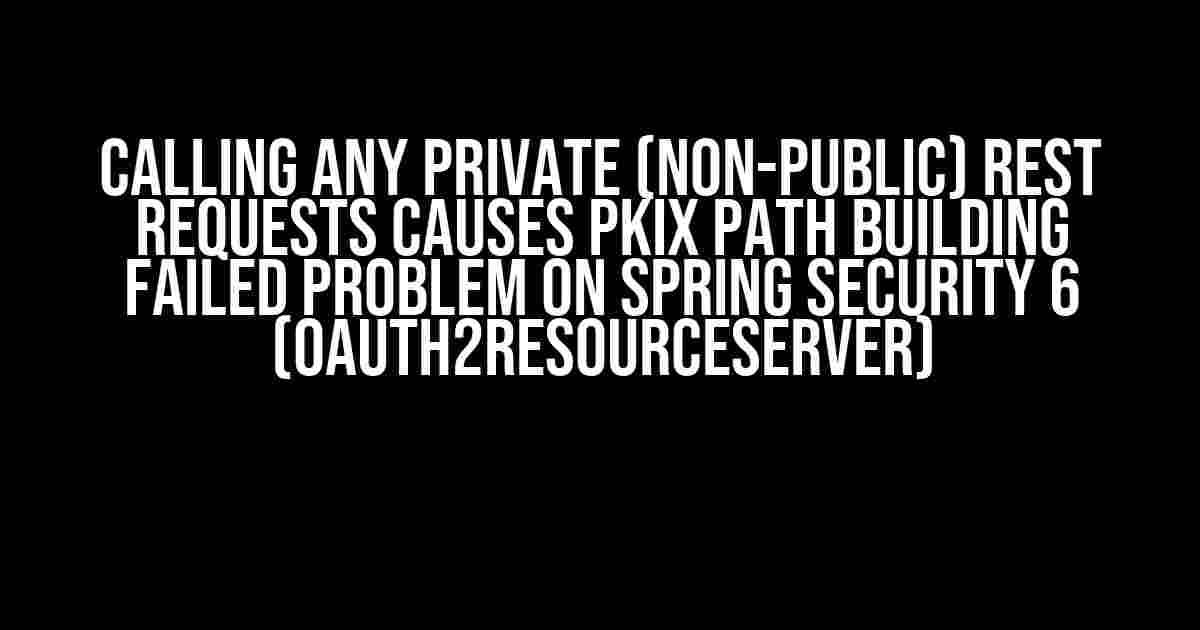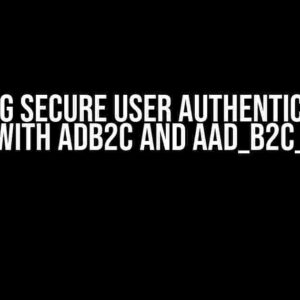Are you tired of encountering the frustrating “PKIX path building failed” error when making private REST requests with Spring Security 6 and OAuth2ResourceServer? You’re not alone! This issue has been plaguing developers for far too long, and it’s time to put an end to it once and for all. In this comprehensive guide, we’ll dive deep into the problem, explore its causes, and provide you with clear, step-by-step solutions to overcome this hurdle and get your private REST requests up and running smoothly.
What is the PKIX path building failed problem?
The PKIX path building failed error occurs when your Spring Security 6 application, configured with OAuth2ResourceServer, attempts to make a private (non-public) REST request to an external server. This issue is often accompanied by an SSLHandshakeException, indicating that the underlying HTTPS connection cannot be established due to certificate validation failures.
But why does this happen? The root cause lies in the way Spring Security 6 handles SSL/TLS certificates when making private REST requests.
The Role of TrustManagers in Spring Security 6
In Spring Security 6, the TrustManager is responsible for verifying the trustworthiness of the server’s SSL/TLS certificate. By default, the TrustManager is configured to use the JDK’s default truststore, which contains a list of trusted Certificate Authorities (CAs). When making a private REST request, the TrustManager attempts to validate the server’s certificate against this truststore. If the certificate is not found or cannot be validated, the PKIX path building failed error is thrown.
Solving the PKIX Path Building Failed Problem
Now that we understand the root cause of the issue, let’s explore the solutions to overcome this problem.
Solution 1: Disable Certificate Validation (NOT RECOMMENDED)
The simplest, yet most insecure, solution is to disable certificate validation entirely. This can be achieved by setting the `validateCertificate` property to `false` in your OAuth2ResourceServer configuration:
<bean id="oauth2ResourceServer" class="org.springframework.security.oauth2.provider.client.OAuth2ResourceServerConfigurer">
<property name="validateCertificate" value="false"/>
</bean>
**Warning:** Disabling certificate validation compromises the security of your application, making it vulnerable to man-in-the-middle attacks and other security threats. This solution is not recommended and should only be used for testing or development purposes.
Solution 2: Add the Server’s Certificate to the Truststore
A more secure approach is to add the server’s SSL/TLS certificate to the truststore. This can be done by importing the certificate into the JDK’s default truststore or by creating a custom truststore.
**Option 1: Import Certificate into JDK’s Default Truststore**
keytool -importcert -alias mycert -file mycert.cer -keystore $JAVA_HOME/jre/lib/security/cacerts
**Option 2: Create a Custom Truststore**
keytool -genkeypair -alias mycert -keyalg RSA -keystore mytruststore.jks keytool -importcert -alias mycert -file mycert.cer -keystore mytruststore.jks
In your Spring Security 6 configuration, specify the custom truststore:
<bean id="oauth2ResourceServer" class="org.springframework.security.oauth2.provider.client.OAuth2ResourceServerConfigurer">
<property name="trustStore" value="mytruststore.jks"/>
<property name="trustStorePassword" value="mypassword"/>
</bean>
Solution 3: Implement a Custom TrustManager
A more elegant solution is to implement a custom TrustManager that allows you to control the certificate validation process. This approach provides greater flexibility and customization options.
First, create a custom TrustManager implementation:
public class CustomTrustManager implements X509TrustManager {
@Override
public void checkClientTrusted(X509Certificate[] certificates, String authType) throws CertificateException {
// Custom certificate validation logic
}
@Override
public void checkServerTrusted(X509Certificate[] certificates, String authType) throws CertificateException {
// Custom certificate validation logic
}
@Override
public X509Certificate[] getAcceptedIssuers() {
return new X509Certificate[0];
}
}
Then, configure your OAuth2ResourceServer to use the custom TrustManager:
<bean id="oauth2ResourceServer" class="org.springframework.security.oauth2.provider.client.OAuth2ResourceServerConfigurer">
<property name="trustManager" ref="customTrustManager"/>
</bean>
<bean id="customTrustManager" class="com.example.CustomTrustManager"/>
Best Practices for Private REST Requests with Spring Security 6
In addition to the solutions outlined above, here are some best practices to keep in mind when making private REST requests with Spring Security 6:
- Use SSL/TLS certificates from trusted Certificate Authorities (CAs): Ensure that the server’s SSL/TLS certificate is issued by a trusted CA to simplify the certificate validation process.
- Implement certificate validation: Enforce certificate validation to prevent man-in-the-middle attacks and ensure the authenticity of the server’s identity.
- Use a custom TrustManager for advanced certificate validation: Consider implementing a custom TrustManager to accommodate specific certificate validation requirements or edge cases.
- Regularly update your truststore: Periodically update your truststore to ensure it remains current with the latest trusted CAs and certificates.
- Monitor and troubleshoot SSL/TLS connection issues: Regularly monitor your application’s SSL/TLS connections and troubleshoot any issues that arise to prevent certificate validation failures.
Conclusion
In conclusion, the PKIX path building failed problem when making private REST requests with Spring Security 6 and OAuth2ResourceServer can be resolved by implementing one of the solutions outlined above. By understanding the underlying causes of the issue and following best practices, you can ensure the security and integrity of your private REST requests. Remember to stay vigilant and adapt to changing security requirements to keep your application secure and protected.
| Solution | Description |
|---|---|
| Solution 1: Disable Certificate Validation | Disable certificate validation (NOT RECOMMENDED) |
| Solution 2: Add the Server’s Certificate to the Truststore | Add the server’s SSL/TLS certificate to the truststore |
| Solution 3: Implement a Custom TrustManager | Implement a custom TrustManager for advanced certificate validation |
By following this comprehensive guide, you’ll be well-equipped to overcome the PKIX path building failed problem and ensure the security and integrity of your private REST requests with Spring Security 6 and OAuth2ResourceServer.
Here are the 5 Questions and Answers about “Calling any private (non-public) REST requests causes PKIX path building failed problem on Spring Security 6 (OAuth2ResourceServer)” in HTML format:
Frequently Asked Question
Having trouble with PKIX path building failed error on Spring Security 6? Get the answers to the most frequently asked questions here!
What is the PKIX path building failed error, and how is it related to Spring Security 6?
The PKIX path building failed error occurs when a Java-based application, like Spring Security 6, is unable to validate the certificate chain of a server it is trying to connect to. This error is commonly encountered when making private (non-public) REST requests using OAuth2ResourceServer. It stems from the certificate verification process, which is crippled due to the inability to construct a trustworthy certificate path.
Why does calling private REST requests lead to PKIX path building failed error in Spring Security 6?
When making private REST requests, the server’s certificate is not publicly trusted, causing the certificate verification process to fail. This is because the certificate is not part of the default truststore, and the truststore is not configured to trust the private server’s certificate. As a result, Spring Security 6 throws a PKIX path building failed error.
How can I resolve the PKIX path building failed error when making private REST requests in Spring Security 6?
To resolve this error, you can add the private server’s certificate to the truststore or configure the truststore to trust the certificate. You can also disable certificate verification, but this is not recommended as it compromises security. Another approach is to use a custom TrustManager that trusts the private server’s certificate.
Can I use a custom TrustManager to trust the private server’s certificate in Spring Security 6?
Yes, you can use a custom TrustManager to trust the private server’s certificate. This involves creating a custom TrustManager that trusts the private server’s certificate and then configuring Spring Security 6 to use this custom TrustManager. This approach allows you to trust the private server’s certificate without compromising security.
Are there any security implications of trusting a private server’s certificate in Spring Security 6?
Yes, trusting a private server’s certificate can have security implications. If the private server’s certificate is compromised, your application may be vulnerable to man-in-the-middle attacks. Therefore, it’s essential to ensure that the private server’s certificate is trustworthy and that you’re not compromising your application’s security by trusting it.


